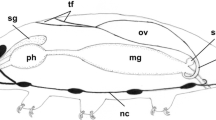Summary
The ultimobranchial body of fresh-water turtles,Pseudemys scripta andChrysemys picta, ultrastructurally and histochemically resembles the gland of other vertebrate groups and the homologous thyroid parafollicular cells of mammals. Characteristic features of all of these tissues are secretory granules measuring approximately 150–250 mμ, a distended endoplasmic reticulum, prominent Golgi regions and large numbers of free ribosomes. Unusual features of the turtle ultimobranchial body are an abundance of large cytoplasmic bodies measuring 800–1000 mμ and a dense, homogenous material within the lumina of the ultimobranchial follicles. The large cytoplasmic bodies usually occur near the luminal portion of the cells and are of similar electron density to the luminal contents, suggesting a possible functional relationship of these two glandular components.
Similar content being viewed by others
References
Chan, A. S., Cipera, J. D., Bélanger, L. F.: The ultimobranchial gland of the chick and its response to a high calcium diet. Rev. canad. Biol.28, 19–31 (1969).
Coleman, R.: Ultrastructural observations on the ultimobranchial bodies of the South African clawed toad,Xenopus laevis Daudin. In: Calcitonin 1969. Proceedings of the Second Internat. Symposium, p. 348–358. London: Heinemann 1970.
Copp, D. H., Cockcroft, D. W., Kueh, Y.: Ultimobranchial origin of calcitonin. Hypocalcemic effects of extracts from chicken glands. Canad. J. Physiol. Pharmacol.45, 1095–1099 (1967).
Ekholm, R., Ericson, L. E.: The ultrastructure of the parafollicular cells of the thyroid gland in the rat. J. Ultrastruct. Res.23, 378–402 (1968).
Lillie, R. D.: Histopathologic technic and practical histochemistry, 3rd ed. New York: McGraw-Hill 1965.
Malmqvist, E., Ericson, L. E., Almqvist, S., Ekholm, R.: Granulated cells, uptake of amine precursors, and calcium-lowering activity in the ultimobranchial body of the domestic fowl. J. Ultrastruct. Res.23, 457–561 (1968).
Nunez, E. A., Gould, R. P., Holt, S. J.: Observations on the dense granules in bat thyroid parafollicular cells. In: Calcitonin. Proceedings of the Symposium on Thyrocalcitonin and the C Cells (S. Taylor, ed.), p. 203–214. London: Heinemann 1968.
Pearse, A. G. E.: Histochemistry, vol. I, 3rd ed. Boston: Little, Brown and Company 1968a.
—: The thyroid parenchymatous cells of Baber, and the nature and function of their C cell successors in thyroid, parathyroid, and ultimobranchial bodies. In: Calcitonin. Proceedings of the Symposium on Thyrocalcitonin and the C cells (S. Taylor, ed.), p. 98–109. London: Heinemann 1968b.
—: The characteristics of the C cell and their significance in relation to those of other endocrine polypeptide cells and to the synthesis, storage and secretion of calcitonin. In: Calcitonin 1969. Proceedings of the Second Internat. Symposium, p. 125–140. London: Heinemann 1970.
—, Carvalheira, A. F.: Cytochemical evidence for an ultimobranchial origin of rodent thyroid C cells. Nature (Lond.)214, 929–930 (1967).
—, Welsch, U.: Ultrastructural characteristics of the thyroid C cells in the summer, autumn and winter states of the hedgehog (Erinaceus europaeus L.), with some reference to other mammalian species. Z. Zellforsch.92, 596–609 (1968).
Robertson, D. R.: The ultimobranchial body inRana pipiens. II. The various cell types and the fate of secretory granules in the parenchyma of the young adult. Z. Zellforsch.67, 584–599 (1965).
—: The ultimobranchial body inRana pipiens. IV. Hypercalcemia and glandular hypertrophy. Z. Zellforsch.85, 441–452 (1968a).
—: The ultimobranchial body inRana pipiens. VI. Hypercalcemia and secretory activity-evidence for the origin of calcitonin. Z. Zellforsch.85, 453–465 (1968b).
—: The ultimobranchial body inRana pipiens. VIII. Effects of extirpation upon calcium distribution and bone cell types. Gen. comp. Endocr.12, 479–490 (1969a).
—: The ultimobranchial body inRana pipiens. IX. Effects of extirpation and transplantation on urinary calcium excretion. Endocrinology84, 1174–1178 (1969b).
—: Some morphological observations of the ultimobranchial gland in the rainbow trout,Salmo gairdneri. J. Anat. (Lond.)105, 115–127 (1969c).
—, Bell, A. L.: The ultimobranchial body inRana pipiens. I. The fine structure. Z. Zellforsch.66, 118–129 (1965).
—, Swartz, G. E.: The development of the ultimobranchial body in the frogPseudacris nigrita triseriata. Trans. Amer. Micr. Soc.83, 330–337 (1964a).
— —: Observations on the ultimobranchial body inRana pipiens. Anat. Rec.148, 219–230 (1964b).
Sehe, C. T.: Comparative studies on the ultimobranchial body in reptiles and birds. Gen. comp. Endocr.5, 45–59 (1965).
Stoeckel, M. E., Porte, A.: Etude ultrastructurale des corps ultimobranchiaux du poulet. Z. Zellforsch.94, 495–512 (1969).
—: A comparative electron microscopic study on the fowl, the pigeon, and the turtle-dove of the C cells localized in the ultimobranchial body and the thyroid. In: Calcitonin 1969. Proceedings of the Second Internat. Symposium, p. 327–338. London: Heinemann 1970.
Tauber, S. D.: The ultimobranchial origin of thyrocalcitonin. Proc. nat. Acad. Sci. (Wash.)58, 1684–1687 (1967).
Zeigel, R. F., Dalton, A. J.: Speculations based on the morphology of Golgi systems in several types of protein-secreting cells. J. Cell Biol.15, 45–54 (1962).
Author information
Authors and Affiliations
Additional information
Scientific Contribution No. 430, Storrs Agricultural Experiment Station, University of Connecticut. This study was supported by Grant GB 7619 from the National Science Foundation and grants from the University of Connecticut Research Foundation.
We wish to express our thanks to Mrs. Elizabeth Johnson and Mr. Joseph Waidalowski for their skillful technical assistance and to Dr. Carroll Burke for encouragement and use of the Electron Microscopy Laboratory.
Rights and permissions
About this article
Cite this article
Khairallah, L.H., Clark, N.B. Ultrastructure and histochemistry of the ultimobranchial body of fresh-water turtles. Z.Zellforsch 113, 311–321 (1971). https://doi.org/10.1007/BF00968542
Received:
Issue Date:
DOI: https://doi.org/10.1007/BF00968542




